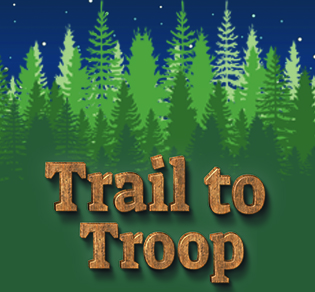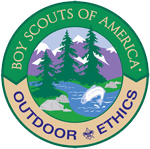October 20-22, 2023
Long Acres Ranch
2335 Richmond Pkwy
Richmond, TX, 77469
 Trail to Troop is an overnight campout aimed primarily at fostering relationships between Webelos and Arrow of Light Scouts (4th and 5th graders) and Scouts BSA as Scouts prepare to make their transition into the Scouts BSA program. Scouts BSA troops work with the Webelos Scouts in a variety of activities and games, aimed at furthering their understanding of Scouting and the Scouts BSA program.
Trail to Troop is an overnight campout aimed primarily at fostering relationships between Webelos and Arrow of Light Scouts (4th and 5th graders) and Scouts BSA as Scouts prepare to make their transition into the Scouts BSA program. Scouts BSA troops work with the Webelos Scouts in a variety of activities and games, aimed at furthering their understanding of Scouting and the Scouts BSA program.
Learn more about Webelos-to-Scouts BSA transition and information to help assist Scouts as they make the important decision on which troop to join and questions to ask the troop leadership at www.shacbsa.org/webelos. Find area troops at shacbsa.org/join-troop.
Registration
Registration is a two-step process. Registration is completed by the den leader or unit leader.
Part 1: RSVP: Every unit needs to RSVP by September roundtable to let the event staff if you are attending. Estimated numbers are provided to the council so the district can reserve the appropriate number of campsites and program areas for the event.
Part 1: RSVP
Part 2: Payment: The registration fee is $10 per Scout and $5 per adult and includes Saturday evening dinner. Registration is completed online with credit card or electronic check. There is no onsite registration; full payment must be made prior to arrival. To make changes to the initial registration, use the link provided in the emailed receipt. Council refund policy.
Part 2: Payment
What to Bring
Suggested Scout Equipment List
|
Suggested Pack Equipment List
|
- Ground cloth/cover
- Tent
- Sleeping bag
- Extra blankets
- Pillow
- Mess kit with utensils
- Daypack with light snack, sunscreen, bug spray, personal first aid kit
- Drinking cup / bottle to carry to activities
- Field uniform (Scout uniform)
- Activity uniform (Scouting t-shirt)
- Change of clothes – at least two days worth, appropriate for the weather
- Toilet paper
- Jacket/sweatshirt
- Rain gear
- Hat or head cover
- Personal toiletries – soap, towel, toothpaste, toothbrush, comb, medication
- nightwear
- Flashlight, with fresh batteries
- Extra batteries
- Snacks
- Camp chair or stool
- Handbook
|
- BSA Health and Medical Record (Parts A & B) for every participant
- Canopy or dining fly
- Pack / den flags
- First aid kit
- Folding tables
- Trash bags
- Firewood
- Lanterns – propane or battery for campsite
- Meals (Saturday breakfast, non-cooking lunch, Sunday non-cooking breakfast)
- Stove – small propane
- Cooking gear – pots, pans, utensils, food
- Cleaning gear – dishwashing soap, buckets, scouring sponge/dishcloth
- Water containers with lids to carry water
- Duty roster and meal plans for the den
|
What NOT to bring to camp: Alcohol, electronics/game equipment, firearms, guns and ammunition, sheath knives, fireworks, illegal drugs, liquid fuel lanterns or stoves, pets, scooters, skates, skateboards, valuables
Tentative Schedule
| |
Saturday
|
| |
9:00 am |
Scouts arrive and check-in |
| |
9:30 am |
Opening ceremony |
| |
10:00 am |
First activity session |
| |
11:00 am |
Second activity session |
| |
12:00 pm |
Third activity session |
| |
1:00 pm |
Fourth activity session (lunch) |
| |
2:00 pm |
Fifth activity session |
| |
3:00 pm |
Sixth activity session |
| |
4:00 pm |
Seventh activity session |
| |
5:00 pm |
Dinner and closing ceremony |
| |
Sunday
|
| |
7:00 am |
Wake-up |
| |
8:00 am |
Campsite inspection and checkout |
Leave No Trace
 Instilling values in young people and preparing them to make moral and ethical choices throughout their lifetime is the mission of the Boy Scouts of America. Leave No Trace helps reinforce that mission, and reminds us to respect the rights of other users of the outdoors as well as future generations. Appreciation for our natural environment and a knowledge of the interrelationships of nature bolster our respect and reverence toward the environment and nature. Leave No Trace is an awareness and an attitude rather than a set of rules. It applies in your backyard or local park as much as in the backcountry. We should all practice Leave No Trace in our thinking and actions–wherever we go.
Instilling values in young people and preparing them to make moral and ethical choices throughout their lifetime is the mission of the Boy Scouts of America. Leave No Trace helps reinforce that mission, and reminds us to respect the rights of other users of the outdoors as well as future generations. Appreciation for our natural environment and a knowledge of the interrelationships of nature bolster our respect and reverence toward the environment and nature. Leave No Trace is an awareness and an attitude rather than a set of rules. It applies in your backyard or local park as much as in the backcountry. We should all practice Leave No Trace in our thinking and actions–wherever we go.
The principles of Leave No Trace might seem unimportant until you consider the combined effects of millions of outdoor visitors. One poorly located campsite or campfire may have little significance, but thousands of such instances seriously degrade the outdoor experience for all. Leaving no trace is everyone’s responsibility. All participants are asked to follow the seven principles of Leave No Trace.
- Plan Ahead and Prepare
- Travel and Camp on Durable Surfaces
- Dispose of Waste Properly (Pack It In, Pack It Out)
- Leave What You Find
- Minimize Campfire Impacts
- Respect Wildlife
- Be Considerate of Other Visitors
Photographs
Notice! Please be advised that promotional videotaping/photography may be in progress at any time at an event. Your entrance constitutes your agreement that the council and district has the right to reproduce your likeness in videography/photography for promotion (e.g., publications, internet, newspaper).
Late-breaking Information
For late-breaking news and announcements, join our district Facebook page and sign up for our district e-mail list.
Scouting Safely
 The BSA's Commitment to Safety is ongoing and we want you to know that the safety of our youth, volunteers, staff, and employees cannot be compromised. The Boy Scouts of America puts the utmost importance on the safe and healthy environments for its youth membership. The Sam Houston Area Council takes great strides to ensure the safety of its youth as well as the adult volunteer leadership that interacts with them.
The BSA's Commitment to Safety is ongoing and we want you to know that the safety of our youth, volunteers, staff, and employees cannot be compromised. The Boy Scouts of America puts the utmost importance on the safe and healthy environments for its youth membership. The Sam Houston Area Council takes great strides to ensure the safety of its youth as well as the adult volunteer leadership that interacts with them.
BSA Guide to Safe Scouting policies must be followed. All participants must follow Youth Protection Guidelines at all Scouting events. Highlights include:
- Two-deep leadership on all outings required.
- One-on-one contact between adults and youth members is prohibited.
- The buddy system should be used at all times.
- Discipline must be constructive.
Health and safety must be integrated into everything we do, to the point that no injuries are acceptable beyond those that are readily treatable by Scout-rendered first aid. As an aid in the continuing effort to protect participants in a Scout activity, the BSA National Health and Safety Committee and the Council Services Division of the BSA National Council have developed the "Sweet Sixteen" of BSA safety procedures for physical activity. These 16 points, which embody good judgment and common sense, are applicable to all activities.
Youth Protection Guidelines Guide to Safe Scouting Sweet Sixteen Enterprise Risk Management
Contact
For additional information, contact the event chair, event chair or the district activities chair